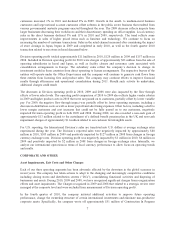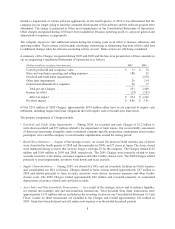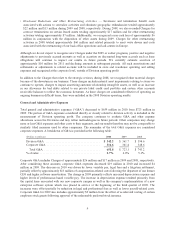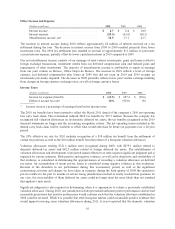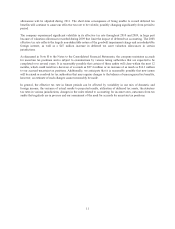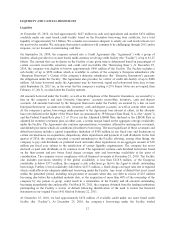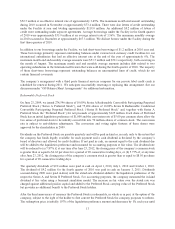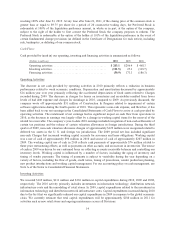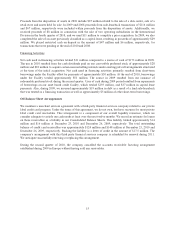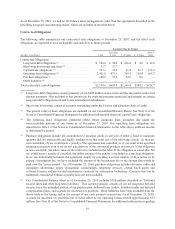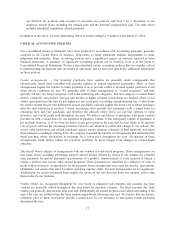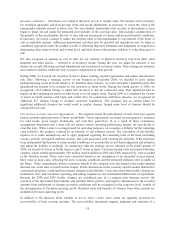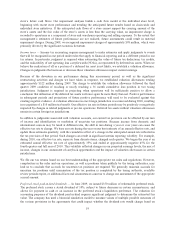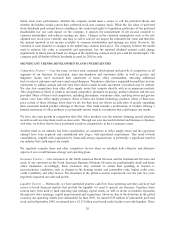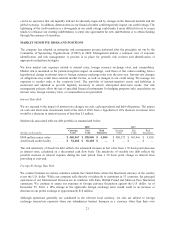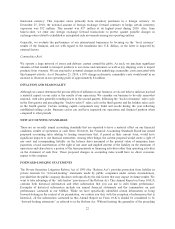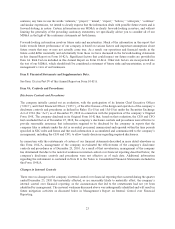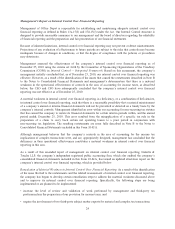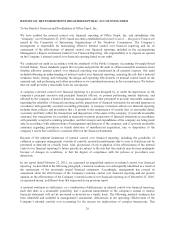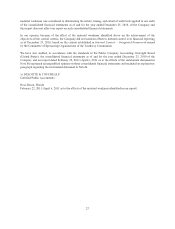Office Depot 2010 Annual Report Download - page 18
Download and view the complete annual report
Please find page 18 of the 2010 Office Depot annual report below. You can navigate through the pages in the report by either clicking on the pages listed below, or by using the keyword search tool below to find specific information within the annual report.our deferred tax positions and accruals for uncertain tax positions and Note J for a discussion of our
employee benefit plans, including the pension plan and the deferred compensation plan. The table above
includes scheduled, acquisition-related payments.
In addition to the above, we have outstanding letters of credit totaling $119 million at December 25, 2010.
CRITICAL ACCOUNTING POLICIES
Our consolidated financial statements have been prepared in accordance with accounting principles generally
accepted in the United States of America. Preparation of these statements requires management to make
judgments and estimates. Some accounting policies have a significant impact on amounts reported in these
financial statements. A summary of significant accounting policies can be found in Note A of the Notes to
Consolidated Financial Statements. We have also identified certain accounting policies that we consider critical
to understanding our business and our results of operations and we have provided below additional information
on those policies.
Vendor arrangements — Our inventory purchases from vendors are generally under arrangements that
automatically renew until cancelled with periodic updates or annual negotiated agreements. Many of these
arrangements require the vendors to make payments to us or provide credits to be used against purchases if and
when certain conditions are met. We generally refer to these arrangements as “vendor programs,” and they
typically fall into two broad categories, with some underlying sub-categories. The first category is volume-based
rebates. Generally, our product costs per unit decline as higher volumes of purchases are reached. Many of our
vendor agreements provide that we pay higher per unit costs prior to reaching a predetermined tier, at which time
the vendor rebates the per unit differential on past purchases, and also applies the lower cost to future purchases
until the next milestone is reached. Current accounting rules provide that companies with a sound basis for
estimating their full year purchases, and therefore the ultimate rebate level, can use that estimate to value
inventory and cost of goods sold throughout the year. We believe our history of purchases with many vendors
provides us with a sound basis for our estimates of purchase volume. If the anticipated volume of purchases is
not reached, however, or if we form the belief at any given point in the year that it is not likely to be reached,
cost of goods sold and the remaining inventory balances are adjusted to reflect that change in our outlook. We
review sales projections and related purchases against vendor program estimates at least quarterly and adjust
these balances accordingly. During 2010, the company expanded the number of arrangements that eliminated this
tiered purchase rebate mechanism in exchange for a lower price throughout the year. An increase in these
arrangements could further reduce the potential variability in gross margin from changes in volume-based
estimates.
The second broad category of arrangements with our vendors is event-based programs. These arrangements can
take many forms, including advertising support, special pricing offered by certain of our vendors for a limited
time, payments for special placement or promotion of a product, reimbursement of costs incurred to launch a
vendor’s product, and various other special programs. These payments are classified as a reduction of costs of
goods sold or inventory, as appropriate for the program. Some arrangements may meet the specific, incremental,
identifiable cost criteria that allow for direct operating expense offset, but such arrangements are not significant.
Additionally, we receive payments from vendors for certain of our activities that lower the vendors’ cost to ship
their product to our facilities.
Vendor rebates are recognized throughout the year based on judgment and estimates and amounts due from
vendors are generally settled throughout the year based on purchase volumes. The final amounts due from
vendors are generally known soon after year-end. Substantially all vendor program receivables outstanding at the
end of the year are settled within the three months immediately following year-end. We believe that our historic
collection rates of these receivables provide a sound basis for our estimates of anticipated vendor payments
throughout the year.
17


